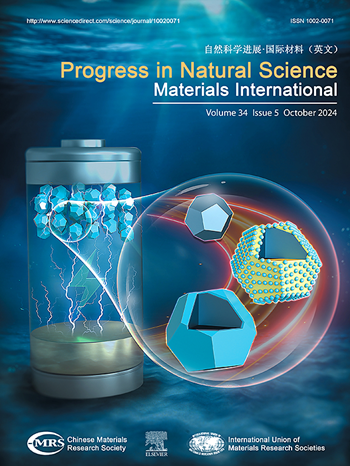通过共掺杂调节b位原子环境改善质子陶瓷燃料电池La0.5Sr1.5MnO4阴极电催化
IF 7.1
2区 材料科学
Q2 MATERIALS SCIENCE, MULTIDISCIPLINARY
Progress in Natural Science: Materials International
Pub Date : 2025-08-01
DOI:10.1016/j.pnsc.2025.05.004
引用次数: 0
摘要
调整k2nif4型材料的b位原子环境为优化电催化性能提供了一种策略方法。本文将共掺杂引入到锰基La0.5Sr1.5MnO4+δ (LSMO)中,产生额外的氧空位,并建立Mn4+/Mn3+和Co4+/Co3+氧化还原对,从而形成高效的电子跳迁途径,提高电催化活性。所得的La0.5Sr1.5Mn0.8Co0.2O4+δ (LSMCO)阴极在质子陶瓷燃料电池(PCFC)中表现出优异的性能,在700°C时提供1491 mW cm - 2的峰值功率密度和0.095 Ω cm2的低极化电阻。这些指标明显超过了先前研究中报道的基于lmos和基于ln2nio4的阴极。电导率弛豫(ECR)实验证明,LSMCO的优异性能源于氧离子迁移加速和质子化动力学增强,从而促进了电极反应的加快。LSMCO具有耐用性强、降解率低的特点,是PCFC阴极的主要候选材料。这项研究强调了共掺杂在重新配置mn基k2nif4相关材料的b位原子环境中的有效性,为设计高性能电催化剂提供了重要的见解。这一发现为推进能量转换技术中的材料提供了一条可行的途径,强调了下一代燃料电池在定制原子环境和优化氧化还原活性之间的协同作用。本文章由计算机程序翻译,如有差异,请以英文原文为准。
Modulating B-site atomic environment via Co-doping to meliorate La0.5Sr1.5MnO4 cathode electrocatalysis for protonic ceramic fuel cells
Tailoring the B-site atomic environment in K2NiF4-type materials offers a strategic approach to optimize electrocatalytic performance. Herein, Co-doping is introduced into the manganite-based La0.5Sr1.5MnO4+δ (LSMO) to generate additional oxygen vacancies and establish Mn4+/Mn3+ and Co4+/Co3+ redox couples, which create efficient electron-hopping pathways and enhance electrocatalytic activity. The resultant La0.5Sr1.5Mn0.8Co0.2O4+δ (LSMCO) cathode demonstrates exceptional performance in a protonic ceramic fuel cell (PCFC), delivering a peak power density of 1491 mW cm−2 with a low polarization resistance of 0.095 Ω cm2 at 700 °C. These metrics significantly surpass those of LSMO-based and Ln2NiO4-based cathodes reported in prior studies. The superior performance stems from accelerated oxygen ion migration and enhanced protonation kinetics in LSMCO, as evidenced by electrical conductivity relaxation (ECR) experiments, which promote faster electrode reaction. Coupled with robust durability with minimal degradation, LSMCO emerges as a leading PCFC cathode candidate. This study underscores the effectiveness of Co-doping in reconfiguring the B-site atomic environment of Mn-based K2NiF4-related materials, providing critical insights for designing high-performance electrocatalysts. The findings highlight a viable pathway for advancing materials in energy conversion technologies, emphasizing the synergy between tailored atomic environments and optimized redox activity for next-generation fuel cells.
求助全文
通过发布文献求助,成功后即可免费获取论文全文。
去求助
来源期刊
CiteScore
8.60
自引率
2.10%
发文量
2812
审稿时长
49 days
期刊介绍:
Progress in Natural Science: Materials International provides scientists and engineers throughout the world with a central vehicle for the exchange and dissemination of basic theoretical studies and applied research of advanced materials. The emphasis is placed on original research, both analytical and experimental, which is of permanent interest to engineers and scientists, covering all aspects of new materials and technologies, such as, energy and environmental materials; advanced structural materials; advanced transportation materials, functional and electronic materials; nano-scale and amorphous materials; health and biological materials; materials modeling and simulation; materials characterization; and so on. The latest research achievements and innovative papers in basic theoretical studies and applied research of material science will be carefully selected and promptly reported. Thus, the aim of this Journal is to serve the global materials science and technology community with the latest research findings.
As a service to readers, an international bibliography of recent publications in advanced materials is published bimonthly.

 求助内容:
求助内容: 应助结果提醒方式:
应助结果提醒方式:


